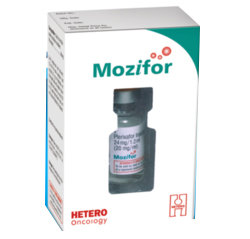Plerixafor
About Plerixafor
Plerixafor belongs to the class of hemopoietic stem cell mobilizer. It is used in the treatment of Non-Hodgkin’s Disease (a blood cancer that affects your lymph system) and multiple myeloma (a type of cancer that affects the plasma cells of the bone marrow) in combination with granulocyte-colony stimulating factor (G-CSF).
Plerixafor contains Plerixafor, which belongs to the hemopoietic stem cell mobilizer class or drugs. It works by binding to the chemokine receptor CXCR4 and inhibits the binding of its cognate ligand CXCL12.
Plerixafor may cause certain side effects, such as nausea, vomiting, headache, dizziness, diarrhoea, flatulence, fatigue, and pain at the site of injection. These side effects do not require medical attention and gradually resolve over time. A trained healthcare professional will administer it. Do not self-administer.
Avoid taking it and inform your doctor if you are allergic to Plerixafor or its components. Before administration, inform your doctor if you have liver/kidney disease, cardiac disorders, blood disorders or respiratory conditions. This medicine is known to cause fetal harm in pregnant women. Hence, inform your doctor if you are pregnant or are planning to become pregnant. Breastfeeding should be discontinued during the treatment.
Uses of Plerixafor
Medicinal Benefits
Plerixafor contains Plerixafor, which belongs to the hemopoietic stem cell mobilizer class or drugs. It works by binding to the chemokine receptor CXCR4 and inhibiting its cognate ligand CXCL12 binding. This mobilizes hematopoietic stem cells to the peripheral blood for collection and subsequent autologous transplantation in cancer patients.
Directions for Use
Storage
Side Effects of Plerixafor
- Nausea
- Dizziness
- Stomach upset
- Headache
- Vomiting
- Insomnia
- Arthralgia
- Diarrhoea
- Pain at the site of injection
Drug Warnings
Plerixafor should be avoided if you are allergic to it or any other components present in it. Let your doctor know about your complete medical history, including current medication, to rule out any side effects/interactions. Before administration, inform your doctor if you have liver/kidney disease, cardiac disorders, blood disorders, anaemia, or respiratory conditions. Plerixafor may cause the potential for tumor cell mobilization in leukemia patients, haematological effects, and splenic rupture in some patients. Hence, careful monitoring should be done during the entire treatment. This medicine is known to cause fetal harm in pregnant women. Hence, inform your doctor if you are pregnant or are planning to become pregnant. Breastfeeding should be discontinued in nursing mothers during the treatment. Plerixafor should be avoided in children as safety is not established.
Drug Interactions
Drug-Drug Interactions: No interactions found.
Drug-Food Interactions: No interactions found.
Drug-Disease Interactions: Inform your doctor if you have kidney or liver disease, blood disorders, and pulmonary disorders before receiving Plerixafor.
Drug-Drug Interactions Checker List:
Safety Advice

Alcohol
unsafeIt is unknown whether Plerixafor interacts with alcohol or not. Please consult your doctor.

Pregnancy
unsafePlerixafor is not recommended for use in pregnancy as it may harm your fetus. Hence, if you are pregnant or planning pregnancy, inform your doctor before receiving Plerixafor. Effective birth control is necessary during treatment and for one week after your last dose.

Breast Feeding
unsafePlerixafor is not recommended if you are breastfeeding. You should not breastfeed while taking this medication and for one week after your last dose.

Driving
not applicablePlerixafor is generally administered to hospitalized patients. Driving is not advised after taking this medicine.

Liver
cautionIf you have a pre-existing or a history of liver disease, inform your doctor before receiving Plerixafor. A dose adjustment may be made, or a suitable alternative may be advised based on your condition.

Kidney
cautionIf you have a pre-existing or a history of kidney disease, inform your doctor before receiving Plerixafor. A dose adjustment may be made, or a suitable alternative may be advised based on your condition.

Children
unsafePlerixafor is not recommended for use in children as the safety and efficacy are not established.
Habit Forming
Diet & Lifestyle Advise
- After your treatment begins, several dietary adjustments can help you control side effects.
- Anyone suffering from a chronic illness, including cancer, should consume foods high in protein, healthy fats, whole grains, and vitamins and minerals.
- Plant-based proteins are among the greatest meals to take during chemotherapy or other cancer treatments. They have the highest concentrations of vitamins and minerals, such as nuts, seeds, beans, and legumes.
- Eat a healthy diet and exercise regularly to maintain proper weight.
- Include leafy vegetables, citrus fruits, fatty fish, berries, yoghurt, apples, peaches, cauliflower, cabbage, broccoli, beans, and herbs.
- De-stress yourself by meditating, reading books, taking a warm bubble bath or listening to soothing music.
- Get optimal sleep; rest well.
- Avoid smoking and alcohol consumption.
- Avoid fast and fried food, processed meats, refined carbs and added sugars.
Special Advise
- A blood test should be performed, such as LFT, RFT, and PFT, to check for liver function and pulmonary function.
- Weekly blood tests should be done during the treatment to check for CBC (Complete blood count).
Patients Concern
Disease/Condition Glossary
Non-Hodgkin’s lymphoma: Non-Hodgkin’s disease is a blood cancer that affects your lymph system. It causes the uncontrollable growth of cancer cells in the lymph nodes. The lymph system is a part of the immune system which protects your body from disease and infections. Symptoms include lymph node swelling, abdominal pain, chest pain, cough, fever, and night sweats.
Multiple myeloma: It is a type of cancerous tumour that affects the plasma cells of the bone marrow. These cells collect in the bone marrow and divide uncontrollably, leading to kidney and bone damage. Symptoms include bone pain, loss of appetite, fever, and frequent infections. Generally, multiple myeloma cannot be cured, but the signs and symptoms can be reduced greatly or disappear after a period of time.
FAQs
Plerixafor contains Plerixafor, which works by binding to the chemokine receptor CXCR4 and inhibits the binding of its cognate ligand CXCL12.
Plerixafor may cause tumor cell mobilization and haematological effects such as increased lymphocytes, decreased platelet count, and splenic rupture in some patients. Hence, inform your oncologist about your complete medical history, including current medication, to rule out any side effects/interactions.




